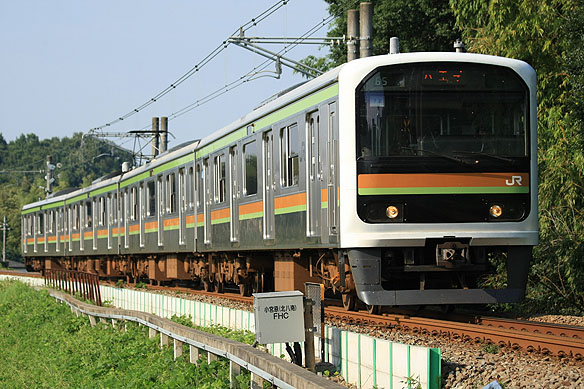Background and overview
JR East diverted 209-3100 series EMU to the used on rural services of Kawagoe and Hachiko lines with some modification in order to displace superannuated 103-3000/-3500 series. They were designed based on 209-3000 series. Some vehicles were diverted Tokyo Waterfront Area Rapid Transit 70-000 series to and only two intermediate vehicles were newly built. Two 4-car sets consisting 2 powered vehicles and 2 trailer vehicles were delivered in 2004.
Car body
They have 2800mm wide body, incorporating unpainted bead-less light weight
stainless construction. The construction of the body is "two-sheet
construction method" that the pressed stainless sheet and the outside
sheet are combined together and those sheets themselves keep the strength.
The thickness of their skin 1.5mm, 0.3mm thicker than 209-0 series employing
1.2mm thick skin. They have yellowish green and orange coloured waistline
and headline bands running the length of each car below and above the windows.
Cab ends are covered with a Fiber Reinforced Plastics (FRP) painted in
white and black. Their front shape is different from that of 209-0 series.
They additionally have passenger-operated door controls, operating manually
by pushing the button fitted beside the door. Door operating equipments,
featuring pneumatic drive are fitted above the door header of the sliding
doors. Traditional destination rollsigns fitted on the front and side of
the vehicles were replaced with LED destination displays.
Bogies
The 209 series are equipped with DT61 bogies on the powered vehicles and TR246 bogies on the trailers, featuring the single link traction device. Twin Disc (TD) flexible joint employing deflecting plates made of carbon-fiber reinforced plastic (CFRP) is applied for power transmission device. Their brake rigging is a single tread brake for powered and both directly the single disk and the single tread brake for trailer.
Traction unit and ancillary equipments
Class moha209-3100 vehicles are equipped with 3-step Variable-frequency drive (VFD) traction system, SC41A or SC41C, which controls 8 traction motors, MT68 or MT73, with a power output of 95kW on vehicle basis including class moha208-3100. This traction system features modular-unit low withstand voltage Gate Turn Off (GTO) thyristor. Class moha208-3100 powered intermediate vehicles are equipped with an auxiliary power unit, SC37 or SC37C with a power output of 210kVA featuring GTO thyristor under their floor. Class moha209-3100 powered intermediate vehicles are equipped with a compact diamond-shaped current pickup, PS28A, on their roof. Class moha208 powered intermediate vehicles and class kuha209 trailer end vehicles are equipped with a motor driven screw air compressor, MH3096-C1600S under their floor. 209 series employ the electric commanding brake with regenerative braking.
Accommodation
Former Tokyo Waterfront Area Rapid Transit 70-000 series are equipped with
LED displays for providing passenger information in zigzags and door chimes
are fitted above the door header of the sliding doors. However, JR East
equipped 209-3100 series with LED displays at all their doorway.
Operations
They entered rural revenue services of Hachiko lines in April, 2005. However, 209-3100 series train sets began to be displaced with 209-3500 series and E231-3000 series, and eventually were completely withdrawn in January, 2022. |
|

